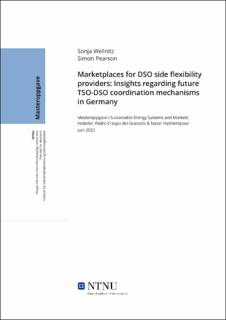| dc.description.abstract | Like many European countries, Germany plans to increase the share of renewable electricity generation within its power system to mitigate the effects of the anthropogenic climate change. However, the intermittent nature and the spatial allocation of the \acf{res} all over Germany pose a challenge as they will lead to an increased need for flexibility options and increased congestion in the transmission grids. In this thesis, we research the integration of a powerful yet largely untouched flexibility resource: \acfp{der} connected to the \ac{dso} grid. The thesis is written following a paper-based format. Therefore, we investigate two different approaches to this topic.
In the first paper, in which we extend the research we have conducted as part of our specialization project in the fall semester of 2021, we explore possible integration mechanisms for these flexibility options. Currently, there is no advanced regulatory system for including the large-scale use of \acp{der} into the established electricity markets. We investigate the application of load flexibility \acp{der} can provide for assisting the re-dispatch necessary in electricity markets that employ a zonal pricing mechanism. Using a deterministic techno-economic optimization model, we implement two different \ac{tso}-\ac{dso} coordination schemes with varying levels of involvement of the \acp{dso} and compare their performance with a business-as-usual case in one historical scenario from 2015 and one prediction for 2030. Findings include that while both cases improve the system-wide re-dispatch concerning volume and cost, the centralized framework outperforms the decentralized one. However, we find the decentralized framework to be more realistic to implement as it preserves the interests of the different stakeholders. Furthermore, we find the average value of optimal load-shifting to not be high enough in 2015 to incentivize investment in this area. However, at the higher percentages of generation from \ac{res} in the future scenario, this value becomes promising and using \acp{der} for this purpose may provide long-term benefits to the system operators and owners of assets alike.
In the second paper, we expand our focus and research possible methods and additional applications to improve the value of load shifting further while considering the insights from the first paper. We investigate how using the \ac{dso} side flexibility not only for the re-dispatch but also for the intraday market improves the financial incentives to provide this flexibility service to the system. To do so, we enhance the model from the first paper to a two-stage stochastic techno-economic optimization model adopting the principle of coordinated bidding. Regarding the flexibility integration into the re-dispatch, we use a decentralized \ac{tso}-\ac{dso} coordination framework. We found that, on the one hand, accessing more than one market results in a higher value of the \ac{dso} side flexibility. On the other hand, it also allows the \ac{dso} side flexibility providers connected to nodes without re-dispatch in the respective time step to offer their service to the system. Therefore, the multi-market access improves the reward potential of this flexibility option. | |
